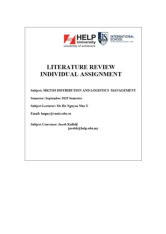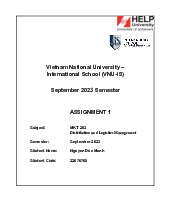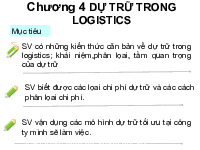













Preview text:
1. INTRODUCTION
In the era of deep global economic integration, logistics management has emerged as a key
factor in the development strategy of enterprises. If in the past, logistics was often understood
simply as the transportation of goods, now the scope of logistics management has expanded significantly.
Modern logistics management includes strategic planning, implementation of activities and
comprehensive control of the flow of goods, services and information in the supply chain. This
change emphasizes the increasingly important role of logistics in optimizing efficiency and
enhancing the competitiveness of enterprises in the international market.
Effective logistics management is a key factor for businesses to gain competitive advantage. It
not only helps save costs, optimize resources but also improves service quality, meeting the
increasing needs of customers. In the context of fierce competition and constant fluctuations in
the market, logistics management plays an important role in ensuring flexibility and the ability
to respond quickly to changes. This is the foundation for businesses to develop sustainably and
build a position in the market.
This paper aims to systematize, decode and evaluate in-depth research works on logistics
management, placed in the context of supply chain management. The focus of analysis includes
key factors such as strategic planning, implementation, operational control, downstream
logistics, upstream logistics, and information coordination. From there, clarify the essential role
of logistics management in satisfying customer needs, and at the same time propose potential
development directions in the future.
2. Theoretical basis of Logistics Management
2.1. Definition of Logistics Management
According to Christopher (2016), logistics management and related information from the point
of origin to the point of consumption to meet customer needs.
Ballou (2018) argues that logistics is not only transportation and warehousing but also an
overall management system related to the entire supply chain operations. Meanwhile, Chopra
and Meindl (2019) emphasize that logistics management is a key element in supply chain
management, where the focus is on cost optimization and increasing customer service value.
2.2. The relationship between Logistics and Supply Chain Management
Logistics is an essential part of supply chain management (SCM). If SCM is understood as a
comprehensive system that includes all activities related to planning, organizing, coordinating
and controlling the flow of goods, services and information from raw material suppliers to end
customers, then logistics plays a key role in ensuring the efficient operation of these flows. The
scope of SCM is broader than logistics, because in addition to transportation and warehousing
management, SCM also includes supplier relationship management, production planning,
product development, order management, distribution and sales.
Meanwhile, the logistics sector mainly focuses on controlling the flow of materials (including
raw materials, work-in-progress, and finished products) and related information in a specific
area, such as transportation, warehouse management, order processing, packaging, and
inventory control. Effective logistics management not only reduces costs and shortens delivery
times, but also improves customer satisfaction. Thanks to the smooth coordination of logistics,
other activities in the supply chain – such as production, distribution, or sales – can be carried
out smoothly, reducing disruptions and ensuring a competitive advantage for the business.
Simply put, logistics is also considered the "backbone" of SCM. Without an effective logistics
system, the entire supply chain will find it difficult to maintain flexibility, sustainability and
high adaptability to market fluctuations.
2.3. Objectives of Logistics Management
The goal of Logistics Management is to ensure efficiency and good performance throughout the
entire process. More specifically, logistics aims to reduce costs, optimize resources such as
human resources, transportation and warehouses, thereby increasing profits and
competitiveness. At the same time, logistics also focuses on improving customer experience
through on-time delivery, stable quality and excellent support services. In addition, in the
context of sustainable development, modern logistics also focuses on green logistics to
minimize environmental impact and reverse logistics to recover and recycle products,
contributing to the construction of a sustainable and friendly supply chain.
For example, Shopee has invested heavily in improving logistics by using automated
warehouses and Shopee Express to cut costs and shorten delivery times. This has not only
improved the customer experience with fast delivery and a smooth return process, but has also
focused on sustainability by reducing packaging waste and implementing eco-friendly logistics.
3. Analyze the key elements in Logistics Management 3.1 Planning
Planning is the initial stage and also the most essential element in logistics management, as it
forms the foundation for the entire process of operations that follows. The planning process
involves not only forecasting the demand for products, but also includes many other important
factors such as determining the appropriate transportation modes (by road, sea, or air), selecting
reliable logistics service providers, building a reasonable warehouse system, and optimizing
transportation routes and related costs. A successful logistics plan helps businesses be more
proactive in responding to market changes, while minimizing the risk of disruptions in the supply chain.
For example, Walmart is known for its accurate demand forecasting through the analysis of
business data and consumer habits. This allows them to manage inventory efficiently, limit
storage costs, and ensure that goods are always available to customers.
Challenges of Planning in Logistics: Despite being a critical detail in logistics management,
making plans faces numerous demanding situations which can considerably have an effect on
performance and reliability. One of the primary problems is call for uncertainty, as patron
choices and marketplace tendencies can shift rapidly, making forecasts much less accurate. In
addition, disruptions in worldwide delivery chains—including herbal disasters, pandemics, or
geopolitical conflicts—could make it tough to lay out solid logistics plans. Another task lies in
balancing fee and carrier quality; companies ought to limit prices at the same time as
nonetheless supplying well timed transport and excessive carrier levels. Moreover, the
complexity of coordinating a couple of stakeholders (suppliers, carriers, warehouses, and
customers) regularly ends in communique gaps and inefficiencies. Finally, with the developing
emphasis on sustainability, logistics making plans ought to now combine inexperienced
practices including lowering carbon emissions and optimizing packaging, which provides some other layer of complexity. 3.2 Implementation
Once logistics planning is complete, the next step is to implement logistics activities on the
ground. This is the stage of converting strategies and plans into concrete actions, including
many important tasks such as transporting raw materials and finished products, storing,
managing warehouses, packaging, processing orders and organizing the distribution system to
the end customer. Effective implementation helps ensure that the flow of goods and information
is always maintained, while minimizing the risk of disruption, as well as optimizing costs and time.
A case in point is Amazon, the world’s largest e-commerce organization, which stands out for its
logistics capabilities. In its warehouse network, Amazon uses advanced technologies such as
automated robots and artificial intelligence to support the organization, movement and
processing of orders. This has significantly reduced the time it takes to complete each order,
while increasing the accuracy of sorting and shipping goods. Furthermore, Amazon has
developed a chain of warehouses and distribution centers across regions, allowing for fast
delivery, even within the same day or within a few hours in certain markets. The combination of
modern technology and an extensive distribution network has enabled Amazon to improve its
logistics operations, provide an excellent customer experience and strengthen its competitive
position in the international arena.
Challenges of Implementation in Logistics: While implementation is the level that turns plans
into actual actions, it additionally faces some demanding situations which could undermine
logistics efficiency. One foremost difficulty is operational errors, consisting of delays in
transportation, wrong order picking, or mismanagement of warehouse inventories, which could
disrupt the glide of goods. Another undertaking is generation integration; despite the fact that
automation and AI carry efficiency, many organizations conflict with excessive funding costs,
worker training, and machine compatibility. Moreover, coordination amongst stakeholders—
which includes suppliers, carriers, and distribution centers—frequently will become complex in
practice, leading to communique gaps and delays. In addition, unexpected outside elements
consisting of visitor congestion, climate conditions, or customs processes can in addition avert
easy implementation. Finally, retaining a stability among speed, cost, and provider great stays a
steady undertaking, as corporations should meet growing patron expectancies at the same time
as retaining operations economically sustainable.
An accurate instance is visible in lots of e-trade companies at some point of height buying
seasons like Black Friday or Singles` Day, while unexpected order surges crush transportation
networks and warehouses, ensuing in not on time deliveries and strained patron providers. 3.3 Control
Logistics control is an essential step to ensure that the entire system operates at its best
efficiency. This process includes monitoring performance, managing costs, checking service
quality and promptly identifying problems so that appropriate adjustments can be made. With
the advancement of technology today, tools such as the Internet of Things (IoT), Big Data and
Artificial Intelligence (AI) are increasingly being applied, allowing businesses to collect and
analyze data in real time. This helps managers not only monitor transportation and warehouse
status, but also predict risks, thereby making decisions faster and more accurately.
In Vietnam, Giao Hang Nhanh (GHN) is also a typical example of applying technology to
logistics control. This enterprise uses an online order management system combined with Big
Data to monitor shipping status and forecast delivery times more accurately. Thanks to that,
GHN can promptly coordinate personnel and vehicles when incidents occur, while optimizing
routes to save costs and improve customer experience.
Challenges of Control in Logistics :Logistics control plays an important role but also faces
many challenges. First of all, the accuracy of data; if information is incomplete or incorrect,
decisions are likely to be wrong. Next is the dependence on technology, when the system has
problems or lacks technical human resources, it will cause disruptions. In addition, the cost of
investing and maintaining monitoring tools is quite high, while coordinating with many partners
in the global supply chain is complicated, leading to difficulty in ensuring synchronization. 3.4. Forward Logistics
Forward logistics is the process of managing and transporting products from the point of origin,
usually from the raw material supplier or manufacturer, to the end customer. This is a traditional
activity in logistics, including many important steps such as transportation, warehousing, order
processing, packaging and distribution. The main goal of forward logistics is to ensure that
goods arrive at the right place, at the right time and in the right quantity as promised, thereby
improving customer satisfaction.
In Vietnam, Vinamilk is a clear example of effective forward logistics implementation. The
company owns a system of factories spread across the country, combined with a large
distribution network including supermarkets, convenience stores, agents and online sales
channels. Thanks to tightly managed forward logistics, Vinamilk's products are always available
on the market on time, ensuring freshness and quality to consumers. This not only helps the
company quickly meet customer needs but also maintains its leading position in the Vietnamese dairy industry.
Challenges of Forward Logistics: Forward logistics, while important, is also fraught with
difficulties. Fluctuating demand complicates maintaining adequate inventory levels.
Transportation is easily disrupted by traffic congestion, rising fuel costs, or unforeseen
incidents. Inventory management and coordination across multiple distribution channels can
also lead to inconsistencies. In addition, pressure from expectations for fast and environmentally
friendly delivery means businesses must optimize costs while meeting sustainability standards. 3.5. Reverse Logistics
Reverse logistics is the process of coordinating the return flow of goods, that is, goods returned
from customers to the company. Unlike forward logistics, which only focuses on transporting
products to consumers, reverse logistics conducts activities after the customer has made a
purchase, including receiving returned goods due to technical problems or non-conformance,
recalling products for recycling of raw materials, remanufacturing to extend the product's life, or
destroying the product if it is no longer usable. Reverse logistics is becoming increasingly
essential in modern supply chain management because it not only helps businesses reduce costs
and recover value from old products, but also benefits the environment and enhances brand reputation.
In Vietnam, Vinamilk has implemented a program to collect and recycle milk cartons at schools,
supermarkets and many public places. After being collected, the cartons will be sent to recycling
factories to produce useful items such as school desks and chairs or construction materials. This
activity not only contributes to reducing waste in the environment but also raises environmental
awareness in the community, especially the younger generation. Similarly, Mobile World also
applies a return policy for electronic products during the warranty period, allowing customers to
return defective products for repair, remanufacturing or replacement. These are all typical
examples of reverse logistics in the context of Vietnam, helping businesses maintain customer
trust and promote sustainable development.
Challenges of Reverse Logistics: Reverse logistics often faces complex and costly returns, while
unpredictable return volumes create uncertainty. Transportation, warehousing, and
environmental compliance costs also increase. Additionally, delays in the return process can
lead to a loss of customer confidence. 3.6 Information Management
Accurate and timely information is crucial to logistics management. ERP systems, blockchain,
and EDI play a role in increasing transparency, reducing fraud, and improving management
efficiency. For example, Viettel Post has applied ERP and Big Data systems in logistics
management to synchronize data from order receiving, sorting, transportation to delivery.
Thanks to this system, businesses can monitor the status of bills of lading in real time, forecast
cargo traffic during peak periods, and optimize the allocation of human resources and vehicles.
In addition, Viettel Post has also deployed a mobile application for customers to easily track the
journey of parcels, thereby increasing transparency, reducing errors and improving user
experience. This is a clear demonstration that information technology plays a key role in
modernizing logistics in Vietnam.
Challenges of Information Management in Logistics: Information control in logistics faces
demanding situations in making sure correct and synchronized statistics throughout a couple of
systems. Cybersecurity risks, excessive era funding costs, and a loss of virtual abilities amongst
personnel also are obstacles. In addition, integrating statistics from a couple of companions can
without problems cause delays and absence of transparency.
4. The role of Logistics Management for customers
Logistics management has a direct impact on customers. First, when logistics operates
efficiently, delivery times are shortened and flexibility is increased. Second, goods delivered on
time, intact, and with better customer service enhance the customer experience. Third, logistics
contributes to strengthening trust and loyalty, as satisfied customers are likely to return and refer
others. Finally, logistics also contributes to sustainable development by reducing emissions and
recycling products, thereby improving brand image. For example, Shopee and Lazada in
Vietnam have invested heavily in domestic logistics systems, especially in building warehouse
networks and finding shipping partners, to provide faster delivery services to consumers.
5. Synthesize and compare previous research
According to Christopher (2016), logistics management plays an essential role in enhancing the
value of services to customers, because ensuring that goods are delivered at the right time, place
and quantity will directly affect consumer satisfaction and loyalty. On the other hand, Ballou
(2018) emphasizes the importance of logistics in minimizing costs, considering it a fundamental
factor for businesses to improve operational efficiency and competitiveness. To complement the
previous two views, Chopra and Meindl (2019) view logistics management as an essential link
between production and consumption, ensuring close connection and cooperation across the
entire supply chain. Recently, many studies have expanded the discussion topic, focusing on
new trends such as digital logistics with the application of advanced technology, green logistics
to limit environmental impact, and sustainable logistics aiming at a balance between economic
efficiency and social responsibility (Nguyen & Tran, 2021; Zhang et al., 2022).
Comparing these perspectives shows that logistics management not only has a strategic element,
influencing the establishment of long-term competitive advantage, but also an operational
element, directly related to the implementation and operation of daily logistics activities.
However, there are still some research aspects that need to be exploited, such as logistics in
emerging markets with many infrastructure and policy constraints, the impact of 4.0 technology
(artificial intelligence, blockchain, Internet of Things) on the transformation of logistics models,
or the role of green logistics in the context of global climate change. Exploiting these aspects
will bring value to both theory and practice, supporting businesses and managers to find the best
solutions to improve logistics efficiency in the modern era. 6. Conclusion
Logistics management plays a crucial role in the management of supply chains, ensuring the
effective movement of goods, services, and information. Research indicates that logistics not
only aids in minimizing costs and improving service quality but also establishes long-term
competitive advantages for companies. The integration of forward logistics, reverse logistics,
and information management provides flexibility and sustainability in operations. In the context
of digital technology and globalization, logistics management is increasingly linked to modern
solutions such as artificial intelligence, the Internet of Things, and blockchain. Furthermore, the
trend towards green logistics presents opportunities for sustainable development, fulfilling
customer demands while enhancing social responsibility. Consequently, logistics management
will remain a strategic key for businesses in the future. 7.References 1.
Christopher, M. (2016). Logistics & supply chain management (5th ed.). Pearson Education Limited. 2.
Ballou, R. H. (2018). Business logistics/supply chain management (6th ed.). Pearson Education. 3.
Chopra, S., & Meindl, P. (2019). Supply chain management: Strategy, planning,
and operation (7th ed.). Pearson. 4.
Lambert, D. M. (2014). Supply chain management: Processes, partnerships,
performance (4th ed.). Supply Chain Management Institute. 5.
Mentzer, J. T., DeWitt, W., Keebler, J. S., Min, S., Nix, N. W., Smith, C. D., &
Zacharia, Z. G. (2001). Defining supply chain management. Journal of Business Logistics, 22(2), 1–25. 6.
OCD. (n.d.). Ví dụ về mô hình B2B tại Việt Nam. OCD.vn. Retrieved from
https://ocd.vn/vi-du-ve-mo-hinh-b2b-tai-viet-nam/ 7.
RTC. (2023, August 18). Viettel Post dẫn đầu xu hướng tự động hóa trong ngành
logistics. RTC.edu.vn. Retrieved from https://rtc.edu.vn/viettel-post-dan-dau-xu-
huong-tu-dong-hoa-trong-nganh-logisti cs/ 8.
Thế Giới Di Động. (2023, April 14). Chính sách đổi trả mới của Thế Giới Di
Động. Thegioididong.com. Retrieved from https://www.thegioididong.com/tin-
tuc/chinh-sach-doi-tra-moi-cua-the-gioi-di-d ong-795660 9.
Quân đội Nhân dân. (2024, March 20). Vinamilk thúc đẩy tiêu dùng xanh bằng
chương trình tái sinh vỏ hộp sữa. Qdnd.vn. Retrieved from
https://www.qdnd.vn/xa-hoi/tin-tuc/vinamilk-thuc-day-tieu-dung-xanh-bang-chu
ong-trinh-tai-sinh-vo-hop-sua-802807 10.
ALS. (n.d.). Tìm hiểu về chuỗi cung ứng của Vinamilk. ALS.com.vn. Retrieved
from https://als.com.vn/tim-hieu-ve-chuoi-cung-ung-cua-vinamilk 11.
VnExpress. (2022, October 5). Giao Hàng Nhanh ứng dụng công nghệ củng cố vị
thế cạnh tranh. Vnexpress.net. Retrieved from https://vnexpress.net/giao-hang-
nhanh-ung-dung-cong-nghe-cung-co-vi-the-canh -tranh-4534433.html 12.
Brands Vietnam. (2023, September 14). Học cách Amazon xây dựng chiến lược
kho hàng để giảm thời gian vận chuyển. Brandsvietnam.com. Retrieved from
https://www.brandsvietnam.com/congdong/topic/334878-hoc-cach-amazon-
xaydung-chien-luoc-kho-hang-de-giam-thoi-gian-van-chuyen 13.
Sheth, J. N., & Sharma, A. (2001). E‐marketing: A global perspective. Journal of
Business & Industrial Marketing, 16(4), 301–316. https://doi.org/10.1002/j.2158- 1592.2001.tb00001.x 14.
Vietnamnet. (2024, June 12). Cách SPX Express đưa Shopee lên đỉnh. Vietnamnet.vn. Retrieved from
https://vietnamnet.vn/cach-spx-express-dua-shopee-len-dinh-2431132.html 15.
Mastering Data Analytics. (n.d.). Walmart biến Big Data thành Big Profits nhờ
Business Intelligence. Mastering-da.com. Retrieved from https://mastering-
da.com/walmart-bien-big-data-thanh-big-profits-nho-business-i ntelligence/ 8.Appendix



